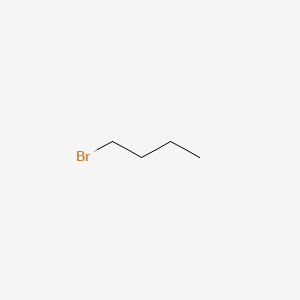

1. Butyl Bromide
2. Butylbromide
1. 109-65-9
2. Butyl Bromide
3. N-butyl Bromide
4. Butane, 1-bromo-
5. 1-butyl Bromide
6. N-butylbromide
7. Butylbromide
8. 1-bromo-butane
9. Ccris 831
10. Bromo Butane
11. Hsdb 2195
12. Einecs 203-691-9
13. Sav6y78u3d
14. Un1126
15. Ai3-15308
16. N-c4h9br
17. N-butyl Bromide [mi]
18. N-butyl Bromide [hsdb]
19. Dtxsid6021903
20. Ec 203-691-9
21. Butyl Bromide, (normal)
22. Butyl Bromide, [normal]
23. Nbutyl Bromide
24. 1butyl Bromide
25. Butane, 1bromo
26. N-bromobutane
27. Dtxcid101903
28. 203-691-9
29. Inchi=1/c4h9br/c1-2-3-4-5/h2-4h2,1h
30. Bromobutane
31. Mfcd00000260
32. 1-bromobutane-1d4
33. Butane, Bromo-
34. 1-bromobutane--d5
35. Unii-sav6y78u3d
36. L-bromobutane
37. N-butylbromid
38. N-butyl Bromine
39. N-butyl-bromide
40. 1-butylbromide
41. 4-bromobutane
42. 1-bromanylbutane
43. Bubr
44. 1 -bromobutane
45. 1- Bromobutane
46. 1-bromo Butane
47. 4-bromo-butane
48. 1-bromo-n-butane
49. N-bu-br
50. Propyl Methyl Bromide
51. 1219805-37-4
52. Schembl8141
53. Chembl160949
54. 1-bromobutane, Analytical Standard
55. Fca72442
56. Hy-y0554
57. Yda19536
58. Stl282740
59. Akos000118760
60. 1-bromobutane, Reagentplus(r), 99%
61. Fb53760
62. Un 1126
63. 1-bromobutane, Reagentplus(r), >=99%
64. Bbu
65. Ls-13004
66. Db-050412
67. B0560
68. Cs-0015331
69. Ns00006184
70. En300-19285
71. 1-bromobutane [un1126] [flammable Liquid]
72. G77188
73. Q59081
74. A802070
75. F0001-0198
76. 1-bromobutane; 1-butyl Bromide; Butyl Bromide; N-butyl Bromide;
| Molecular Weight | 137.02 g/mol |
|---|---|
| Molecular Formula | C4H9Br |
| XLogP3 | 2.8 |
| Hydrogen Bond Donor Count | 0 |
| Hydrogen Bond Acceptor Count | 0 |
| Rotatable Bond Count | 2 |
| Exact Mass | Da |
| Monoisotopic Mass | Da |
| Topological Polar Surface Area | 0 |
| Heavy Atom Count | 5 |
| Formal Charge | 0 |
| Complexity | 13.1 |
| Isotope Atom Count | 0 |
| Defined Atom Stereocenter Count | 0 |
| Undefined Atom Stereocenter Count | 0 |
| Defined Bond Stereocenter Count | 0 |
| Undefined Bond Stereocenter Count | 0 |
| Covalently Bonded Unit Count | 1 |
/n-Butyl bromide administered orally (at the LD50) was deposited mainly in the brain, liver, and perirenal cellular system, and excreted primarily by the lungs./
Kosenko AM, Salyaev VN; Farmakol Toksikol Nov Prod Dhim Sint, Mater, Resp Konf 3: 174-5 (1975)
The hydrolysis of inorganic bromine in the liver following treatment with brominated hydrocarbons was studied. White-mice were administered ...n-butyl-bromide by inhalation in concentrations of 0.75-25 mmol/mL for up to 60 minutes. ...Concentrations of inorganic bromide in the liver were higher in animals that inhaled saturated, brominated hydrocarbons /(including n-butyl bromide)/ than in those that inhaled the unsaturated compounds. The degree of hydrolysis was also higher with the saturated compounds than with the unsaturated compounds. /It was concluded/ that liver tissue damage is probably caused directly by the brominated hydrocarbons rather than by hydrobromic-acid since this acid is released very slowly during hydrolysis.
Abreu BE, Emerson GA; Univ of California, Berkeley, Pubs in Pharmacol 1: 313-9 (1940)
Rabbits and rats dosed with 1-bromobutane excrete in urine, in addition to butylmercapturic acid, (2-hydroxybutyl)mercapturic acid, (3-hydroxybutyl)mercapturic acid and 3-(butylthio)lactic acid. Although both species excrete both the hydroxybutylmercapturic acids, only traces of the 2-isomer are excreted by the rabbit. The 3-isomer has been isolated from rabbit urine as the dicyclohexylammonium salt. 3-(Butylthio)lactic acid is formed more readily in the rabbit; only traces are excreted by the rat. Traces of the sulphoxide of butylmercapturic acid have been found in rat urine but not in rabbit urine. In the rabbit about 14% and in the rat about 22% of the dose of 1-bromobutane is excreted in the form of the hydroxymercapturic acids. Slices of rat liver incubated with S-butylcysteine or butylmercapturic acid form both (2-hydroxybutyl)mercapturic acid and (3-hydroxybutyl)mercapturic acid, but only the 3-hydroxy acid is formed by slices of rabbit liver. S-Butylglutathione, S-butylcysteinylglycine and S-butylcysteine are excreted in bile by rats dosed with 1-bromobutane. Rabbits and rats dosed with 1,2-epoxybutane excrete (2-hydroxybutyl)mercapturic acid to the extent of about 4% and 11% of the dose respectively. The following have been synthesized: N-acetyl-S-(2-hydroxybutyl)-l-cysteine [(2-hydroxybutyl)mercapturic acid] and N-acetyl-S-(3-hydroxybutyl)-l-cysteine [(3-hydroxybutyl)mercapturic acid] isolated as dicyclohexylammonium salts, N-toluene-p-sulphonyl-S-(2-hydroxybutyl)-l-cysteine, S-butylglutathione and N-acetyl-S-butylcysteinyl-glycine ethyl ester.
PMID:5696863 Full text: https://www.ncbi.nlm.nih.gov/pmc/articles/PMC1187022 James SP et al; Biochem J 109 (5): 727-736 (1968)
Rabbits and rats dosed with 1-bromobutane excrete in urine, in addition to butylmercapturic acid, (2-hydroxybutyl)mercapturic acid, (3-hydroxybutyl)mercapturic acid and 3-(butylthio)lactic acid. In the rabbit about 14% and in the rat about 22% of the dose of 1-bromobutane is excreted in the form of the hydroxymercapturic acids. 1-bromobutane also forms glutathione conjugates. Three kinds of GSH conjugates, including S-butyl GSH, S-butyl cysteine, and (hydroxybutyl)mercapturic acid, have been identified in mice livers after oral dosing with 375-1500 mg/kg of the compound.
